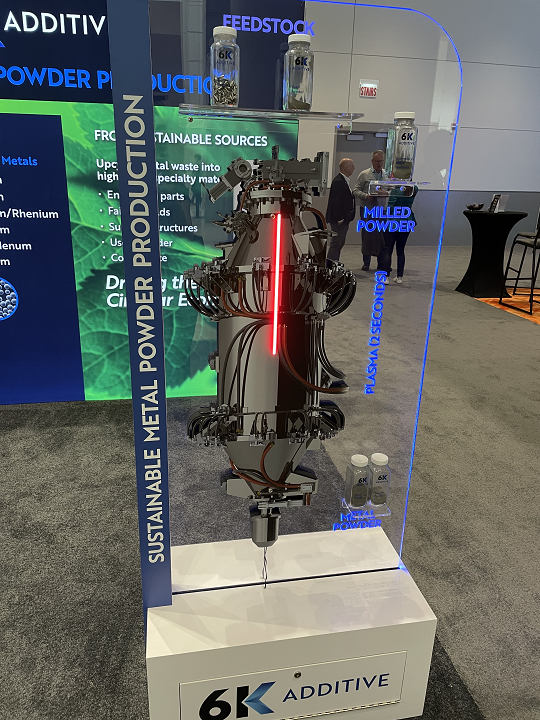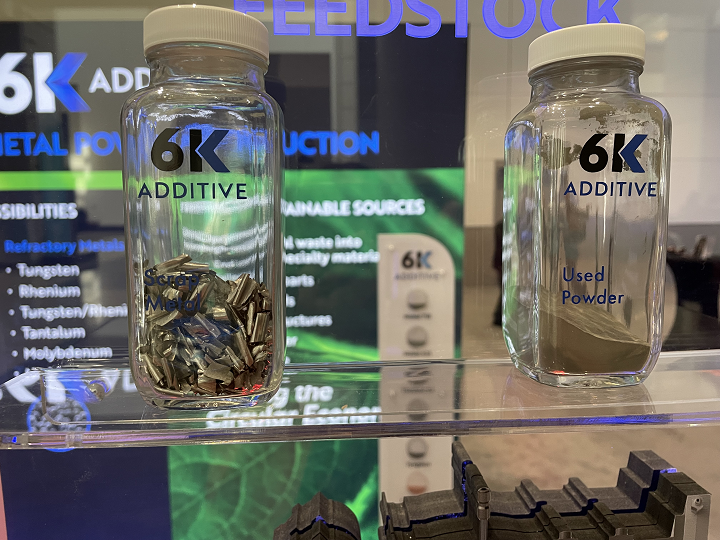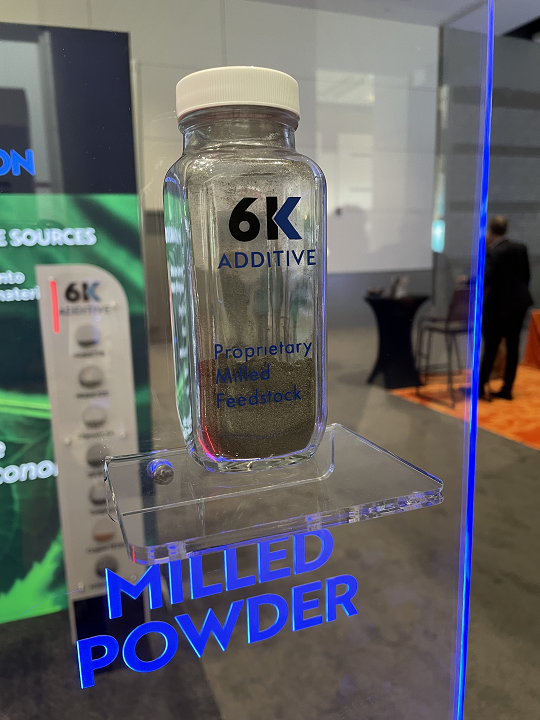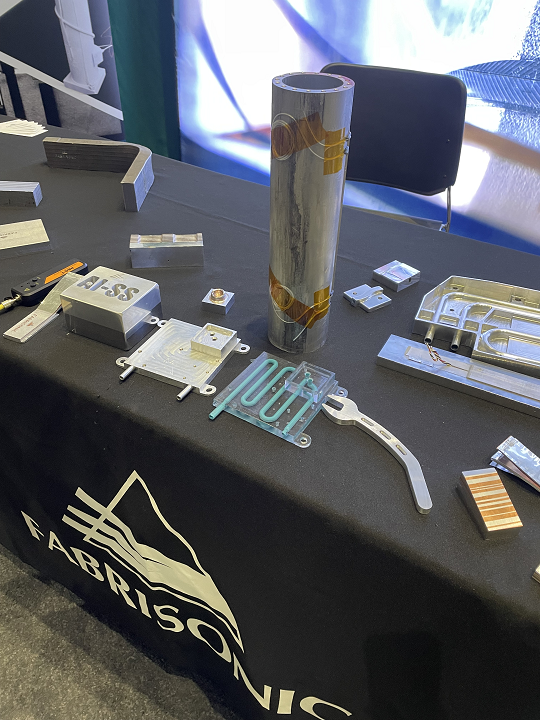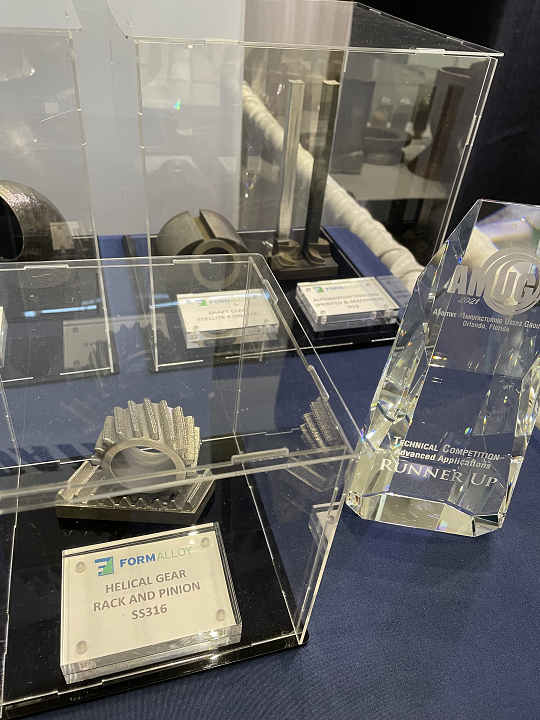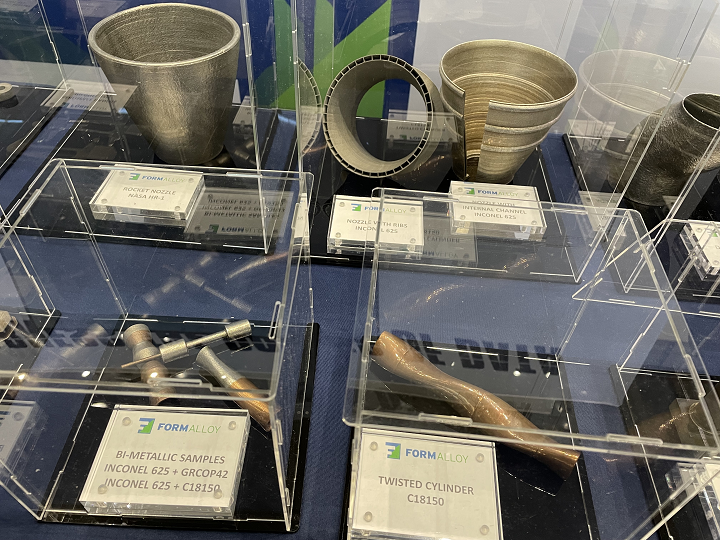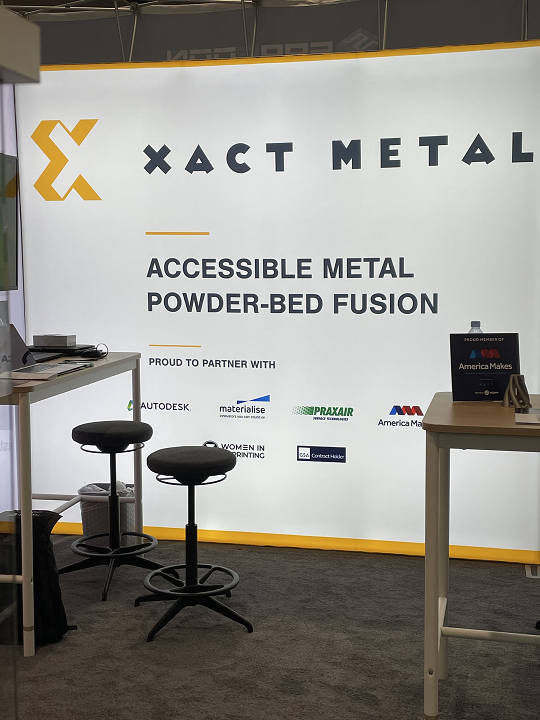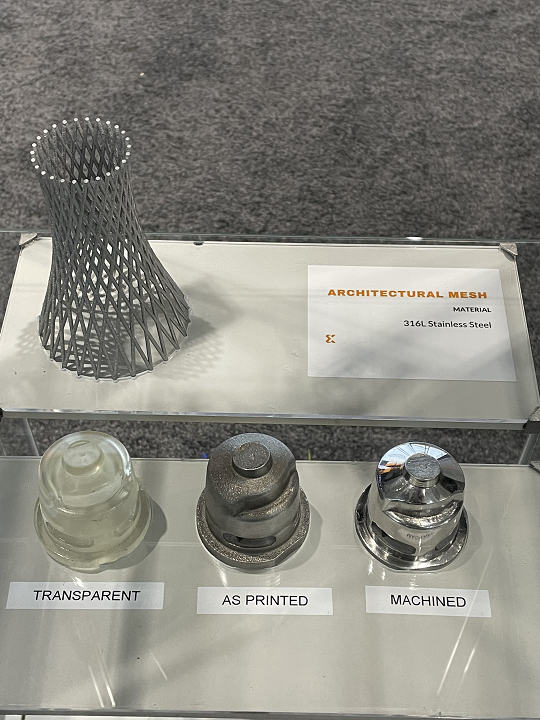There was so much to do and see at IMTS in Chicago this year, with nine specific pavilions on topics like controls and CAD-CAM, quality assurance, metal removal, additive manufacturing, and more. I tried to optimize my time on the show floor by stopping at as many booths as I could for quick visits.
6K’s More Sustainable 3D Printing Metals
6K Additive is one of the main divisions of Massachusetts-based 6K, which focuses on developing more sustainable methods for providing metals used in industrial processes. The company has been busy raising funds the last couple of years, and has had several big announcements this year, including expanding its metal powder line to Europe and signing a joint development agreement with ONE to make battery materials.
Another exciting announcement the startup made this year has to do with its unique microwave plasma process. 6K has long touted how environmentally friendly its UniMelt metal production process is, and this claim has now been backed by hard numbers. The results of an independent lifecycle assessment (LCA) by Foresight Management revealed that UniMelt requires 91% less energy, and emitted 92% less CO2, than traditional processes when making nickel powders.
When I stopped by the 6K Additive booth at UniMelt, Regional Sales Manager Ron Gatte quickly took me through the UniMelt process for “producing the powder more sustainably.”
“We’re taking used chips, used powder, and we mill it to size,” he explained.
Gatte showed me a jar of the milled powder, and I agreed with his assessment that it was fairly “clumpy” before going through the 6K process.
“Then we run it through our plasma and it comes out very spherical and it flows really nice.”
You can definitely see the difference.
AddUp’s 3D Printed Spinal Implants
When I stopped by the AddUp booth, Sarah Plummer, the Director of Global Marketing Communications, showed me a build plate full of titanium alloy spinal implants 3D printed on the company’s FormUp 350 powder bed fusion system. It took about 50 hours to print the implants, which were created in different sizes using “a really great strategy with no supports.”
She explained that the implants were easy to dislodge from the build plate, which was created specifically for IMTS to demonstrate AddUp’s capabilities; the company will be showing two similar plates of medical implants at Formnext in November.
“What we’re trying to show here is we’re full production, mass serial production, and not just prototyping,” Plummer told me. “Our Cincinnati facility is expected to be ISO:13485 certified by October, so that will be very helpful.”
As a matter of fact, the company announced recently that it has successfully achieved ISO 13485:2016 certification, the medical industry standard ensuring that all medical devices meet both compliance laws and customer needs. So I’m certain we’ll hear about more medical applications using AddUp technology in the near future.
Fabrisonic’s Low-Temperature Metal 3D Printing Process
Ohio-based Fabrisonic is, as Production Engineer Matthew Burkhart told me, “a solid state additive manufacturing company” that uses ultrasonic welding and CNC milling to produce parts in a hybrid process called Ultrasonic Additive Manufacturing (UAM).
“We use high-frequency ultrasonic scrubbing in order to scrub off the oxide layers and create a true metallurgical bond,” Burkhart explained. “One advantage of our process is it’s low-temperature, since it’s a friction process. One advantage of our process is it’s low-temperature, since it’s a friction process. The max temperature we’ll reach is 150 to 200° Celsius, and materials like aluminum and copper will only get up to about 50° Celsius.”
These lower temperatures are what allow the company to embed sensors and electronics in parts without damaging them, as well as complete dissimilar metal builds.
“We do a lot of work with aluminum copper laminates. One advantage is you don’t get the intermetallics that you’d get from melting. We get true material properties from metals that we’re working with, so you can do different material property stackups, and get those actual properties in your part.”
Burkhart also reminded me that Fabrisonic is great at manufacturing internal complex geometries, which enables them to 3D print heat exchangers with complex paths.
“Then we can count those layers out, and since our technology is located inside of a CNC mill, we can come in, cut out those channels, weld over top of them, and then cut out the final geometry of the part.”
I knew that Fabrisonic had done some work with NASA in the past, and Burkhart was able to speak to some of the projects, including the production of heat exchangers.
“They have done some extensive research in testing one of our heat exchangers, and we’ve been certified. We haven’t flown with NASA, but we have flown parts on satellites,” he told me.
I wasn’t able to speak with Fabrisonic President and CEO Mark Norfolk during IMTS, but for a great reason. He was in New Orleans the day I was on the floor, accepting the Engineering Materials Achievement Award from ASM International for Fabrisonic’s patented UAM process. The award “recognizes outstanding achievement in materials or materials systems relating to the application of knowledge of materials to an engineering structure or to the design and manufacture of a product.”
Harnessing the Power of Data with FormAlloy
Metal AM startup FormAlloy specializes in the design, research and development, production, and integration of directed energy deposition (DED) systems and components. It’s different from other DED companies because it’s vertically integrated, meaning FormAlloy designs and manufactures components in-house that have been optimized specifically for the DED process.
As Melanie Lang, Co-Founder and CEO of FormAlloy, explained to me, the current tagline for FormAlloy is “harness the power of data.”
“Harnessing the power of data is basically saying, use the power of data to validate your build quality and your repeatability,” she said.
FormAlloy generates a data log once a build is completed, which compiles all the various process parameters and machine data that went into the build. This log makes it possible to predict performance. With its various in-process monitoring and closed-loop control options, combined with its DEDSmart Data software, FormAlloy will pack quite the punch.
“You can just say ‘Yes, this part built according to my plan.’ You’re not guessing,” Lang continued. “You can also use that data to run the machines autonomously, meaning you don’t have to have an operator that’s standing there making adjustments, because you’re making decisions based off of the data, not based off an operator’s perception of what’s happening in the build.”
By harnessing build data for a print job, rather than relying on a human operator in the loop who could be making changes, Lang explained that FormAlloy and its customers can achieve parts with much higher quality.
Xact Metal’s Affordable Powder Bed Fusion
This year was my first time at IMTS, something that Xact Metal could identify with. As CEO Juan Mario Gomez told me, the metal AM company was very excited to attend the event for the first time and show the manufacturing industry what it’s about, which is making powder bed fusion more affordable.
“There’s so much value in powder bed fusion, but today very few people have really been able to get access to that technology to bring into operations,” he said.
The Pennsylvania-based firm brought its smaller XM200G, which features a 150 x 150 x 150 mm build platform and was launched at formnext last year and began shipping in May of this year. Gomez told me “it’s a very well-received machine,” great for research and development applications as well as small volume production.
“Pricing for the XM200G starts at $100,000, making the reality of our mission true,” he said.
The company also just announced the development of the XM300G series, a mid-sized printer with a 300 x 300 x 350 mm build volume that can be upgraded to 300 x 300 x 450 mm and includes one, two, or four lasers at 400 or 700 watts. Add in the system’s interchangeable build platform, and the new XM300G is a great tool for “customers who want to print more volume.” The printer starts shipping in May, and Gomez says the company has already received some orders for it.
“The most exciting part is this printer starts at $200,000,” he told me. “Now you have a printer that’s a mid-sized volume powder bed that’s traditionally been half a million dollars or more starting at $200,000. We’re excited about it because it’s bringing us into discussion with customers about what they want, so we can develop those features into the printer.”
Gomez also told me that Xact Metal printers are capable of achieving “low, aggressive angles.” He showed me a small part that still had supports on it, and explained that he could easily squish them with his fingers and remove them, which saves a lot of time.
“When we looked at this part, we started realizing, ‘Oh my god, we have something so easy to be removed and it would increase the adoption of additive manufacturing in the industrial world,’ because it allows this to be made without having to deal with supports, which is one of the main issues with 3D printing, when the supports become so complicated. So we’re very excited.”
Abigail Nelson, Marketing Communications Manager for Xact Metal, told me the supports also use less powder for a “much greener” process with less material waste.
Finally, Gomez said Xact Metal is working with a new partner to introduce a lower-priced version of its printer that’s affordable to small and medium enterprises “in order to make adoption of metal 3D printing accelerate.” The company recently revealed that this new partner is Prototech, a professional 3D printer provider in South Korea.
Subscribe to Our Email Newsletter
Stay up-to-date on all the latest news from the 3D printing industry and receive information and offers from third party vendors.
You May Also Like
3D Printing Webinar and Event Roundup: April 7, 2024
Webinars and events in the 3D printing industry are picking back up this week! Sea-Air-Space is coming to Maryland, and SAE International is sponsoring a 3D Systems webinar about 3D...
Roboze Brings Performance Polymer 3D Printing to SoCal via New Partnership
High-performance polymer 3D printing firm Roboze has been steadily working to expand its global footprint, with a firm eye on distributed manufacturing, particularly with regard to the oil and gas,...
3D Printing Webinar and Event Roundup: March 3, 2024
In this week’s roundup, we have a lot of events taking place, including SPE’s ANTEC 2024, Futurebuild, the AAOP Annual Meeting, JEC World, and more. Stratasys continues its training courses,...
Advanced Manufacturing Firm Zeda Acquires The Orthopedic Implant Company
Zeda, the San Francisco-based provider of advanced manufacturing solutions, announced that it has acquired The Orthopedic Implant Company (OIC), a medical device manufacturer based in Reno, Nevada, for an undisclosed...


